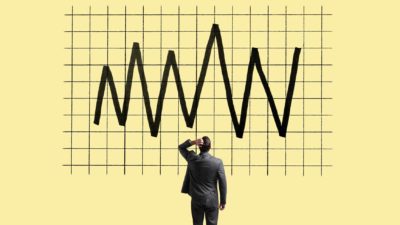It's hard to write an article on a fast-moving story!
But I'll do my best to let you know what we know about Silicon Valley Bank's collapse.
(And for the record, we're publishing it at 9.50am on Monday morning. So it's what we know, right now!)
Here goes:
So, a US bank collapsed over the weekend.
The bank – Silicon Valley Bank – was reportedly the 18th largest bank in the United States.
And the details, it should be said, remain somewhat sketchy.
The general consensus seems to be that SVB managed to mess up in a way similar to what happened to some non-bank lenders in Australia during the GFC.
That's important, because – at least at the moment – it seems the issue is more like what happened in Australia, than what happened in the US, in the GFC.
And there's a world of difference between those two experiences.
But before we get into that, a few things.
First, there is a lot we don't know about what happened to SVB. It's messy and the future is uncertain. Some of what we think we know might turn out to be completely wrong.
Second, the range of 'what might come next' outcomes is very wide. To be sure, some possible outcomes are more likely than others. But there's no hard and fast way to rule things in or out. Because it's not just SVB, but the impact on the system. More on that in a bit.
And last, some disclosures: SVB was a Motley Fool recommendation, some of our staff owned shares (they probably technically still own the shares, but they're very probably worth nothing), and SVB was one of The Motley Fool's banks.
Right… let's get back to it.
The GFC was caused by a few things happening in succession, but the starting point was that banks made terrible loans to people who should never have received them. Those loans were packaged and sold to others as 'assets'. They were, we can say with certainty, (very) low quality assets.
And when the assets were worth less (and often worthless!) you have a problem.
Here in Australia, we had two non-bank lenders that got themselves into a modicum of difficulty – Wizard and Aussie Home Loans. Their loans were cheaper because they made 30 year loans, funded with rolling short term debt facilities (think: 30, 60 or 90 day funding agreements that rolled over each time they fell due).
If you can roll these over (and over and over) for the length of the mortgage you've issued, you're sweet.
And they made money because those short term borrowings were cheaper than the long term mortgages – and the difference was their margin.
If that's already going over your head, here's an example. These aren't the actual numbers, but here's how to think about it:
If you can borrow money at 2% and lend it out at 3%, you make a 1% margin. If you can't roll over that 2% funding, you need to pay it back, immediately, in full. But the money had been used to offer 30 year mortgages… meaning you can't pay back those loans quickly.
And you have a very big problem.
Not with the quality of the loans, like in the US, but a mismatch on your cash flows.
Now, that's a very simplified example of what happened during the GFC. There were more wrinkles, but it suffices for our purposes.
It seems – again, we don't know for sure – that SVB had a similar problem, but rather than being caught out on the availability of funding, like in the GFC, it was rising rates that may have been responsible.
Rising rates (yields) pushes down the value of long term, low-rate bonds. (If you bought a 10-year US Treasury at 2% in the past, no-one is going to buy it off you at face value because they can buy a newer bond at, say, 3% or 3.5%. That means your bonds are worth less.
You can still hold them until maturity and get your money back, but the accountants require you to recognise the current value of the bond… which is less than it used to be.
And that creates a hole. It's an accounting hole, to be fair, but if SVB wanted to – or had to – sell those bonds sooner rather than later, that accounting hole becomes very real.
Now, one more time: those numbers above are illustrative, not SVB's actual numbers. But hopefully you can see why it might have got itself in trouble.
The good news? The loans themselves seem not to be poor quality loans. And matching the assets and liabilities likely wasn't a problem over time.
But in the short term, they had a problem. A big problem.
And here's where things get ugly.
If, as a depositor, you get a sense that maybe, possibly, your bank might be in trouble, you'd yank out your money.
Remember, banks don't hold liquid cash to repay every depositor straight away – they've lent that money to others, who will repay over a number of years.
So the first depositor gets her money back. So does the second. But, at some point, if every depositor wants their money back at the same time, the bank's vaults run dry.
It doesn't mean the money wouldn't have been there, in time – as loans were repaid, the vaults would slowly refill – but the mismatch is the problem.
And depositors know that. So, once they sniff a problem, they all rush for the exits, not wanting to be the one next in line after the bank's vaults are emptied.
Yes, that's a good old-fashioned 'bank run'.
And the reality – and likelihood of a continuation – of that is what seems to have been SVB's death knell.
And that's why the responsible US government entity – the FDIC – stepped in on Friday.
Now, if the loan book turns out to be a high quality one, depositors may get most of their money back (because if the assets and liabilities can be matched, it's only a question of the timing of cash flows, and other banks will likely be able to take over that function).
And, while editing this piece, the US Fed, FDIC and US Treasury announced that all depositors will get all of their money! I mentioned things are moving quickly!
So, that could be where this ends.
Or not.
Maybe the loans aren't as high-quality as they seem? Or maybe panic takes over anyway.
See, the risk is that, having seen SVB's troubles, depositors at other banks get nervous. "What if it happens to my bank?" they might ask.
And if you think that there might be a bank run at your bank, you might try to take your money out first… causing precisely the thing you're worried about.
You can see how panic can spread, right?
Do I think it'll happen? No.
Could it? Yes.
And that's why financial markets are worried.
We know, from the GFC, what financial contagion can look like. It's… not good.
And the antidote to contagious panic is… confidence.
That's exactly what regulators will be trying to instill, through words and deeds (and is why the FDIC took over SVB, and why they made their announcement this morning).
Phew… are you still with me?
Good. That was a long (and necessarily simplistic) explanation. But I think it gets to the heart of the problem, and its potential causes and solutions.
And again, we're working with imperfect information, so don't take it to the, ahem, bank.
But where to from here?
Well, the ASX will open this morning.
Bank shareholders will be a little nervous, worried about what could happen if panic was to spread.
It could dent confidence across the board, too. Financial contagion would have impacts across the economy, not just the banks.
Yes, I have used a lot of conditional language in this piece. Probably more than ever before.
And that's deliberate. I'm not sitting on the fence, but there's a lot we don't know about what's gone down. And no-one knows what the future holds.
So, I'm giving it to you straight.
What I will do, though, is tell you what I'm doing as a result.
Nothing.
Just as I've done during the dozens and dozens of potential panics, downturns, and crashes, over the last two decades.
Here's the thing, though: Some have actually come to pass.
I didn't sell before the GFC. I didn't sell before the COVID crash.
If I had, I could have saved money.
But if I'd also sold before all of the other things that could have gone wrong – but didn't – I would have lost even more by missing out on the long term gains that the market has enjoyed despite those fears.
Now, I could always change my mind as new evidence comes to pass. I doubt it, but it's possible. Signing blank cheque guarantees for any course of action is silly.
It's very, very unlikely, though.
Because the most likely outcome, historically speaking, is that there's no long term damage for Australian investors.
There mightn't even be any short-term damage either.
So, if you have a good long-term track record of guessing which potential crises come to pass, and which don't (hint: if you've forecast 10 of the last 2 market crashes, your track record isn't good), then be my guest to take a punt this time around, too.
Now, if your portfolio is chock full of financial companies, I reckon you've been taking too much risk for a long time, not just in the shadow of the SVB collapse. You really should think about diversifying anyway, and now might be a good time to think about your portfolio.
Not because of this event, per se, but because it's a good reminder that concentration in a single sector is not a good risk management strategy!
Me? I don't own any banks. I'm not selling anything. And I'm not losing any sleep.
I'm trusting in the long term compounding power of a quality diversified portfolio (and the market itself).
Over the long term, that's been a very good strategy.
Fool on!









